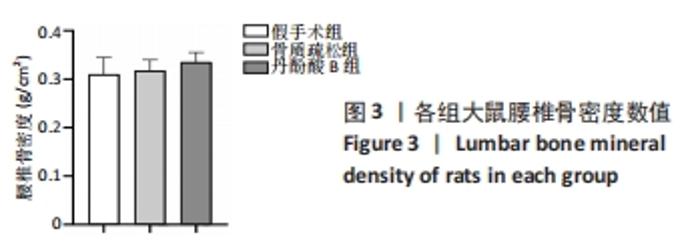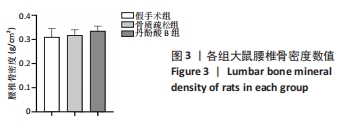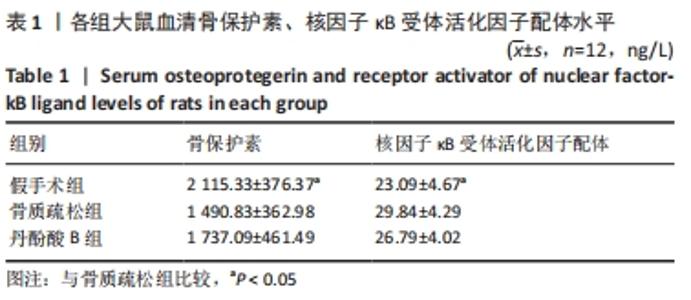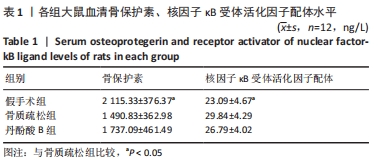[1] SÖZEN T, ÖZıŞıK L, BAŞARAN NÇ. An overview and management of osteoporosis. Eur J Rheumatol. 2017;4(1):46-56.
[2] 蒋燕飞. 女性绝经后发生骨质疏松症的危险因素及其预防措施分析[J]. 中国妇幼保健,2021,36(12):2857-2859.
[3] 张萌萌,张秀珍,邓伟民,等. 骨代谢生化指标临床应用专家共识(2020)[J]. 中国骨质疏松杂志,2020,26(6):781-796.
[4] 赵全如, 谢晓燕. 丹参的化学成分及药理作用研究进展[J]. 广东化工,2021, 48(1):57-59.
[5] 杨伟霞. 丹参对去卵巢骨质疏松大鼠的作用及机制的初步探讨[D]. 昆明:昆明医科大学 ,2020.
[6] 胡广, 关智宇, 张开伟. 三七总皂苷干预去势骨质疏松性骨折模型大鼠的作用机制[J]. 中国组织工程研究,2021,25(2):172-177.
[7] 李兰, 杨一秋, 解继胜. 去卵巢小鼠绝经后骨质疏松模型的建立和综合评定[J]. 右江民族医学院学报,2021,43(1):6-10.
[8] FANG J, YANG L, ZHANG R, et al. Are there differences between Sprague-Dawley and Wistar rats in long-term effects of ovariectomy as a model for postmenopausal osteoporosis. Int J Clin Exp Pathol 2015;8(2):1491-1502.
[9] GAO X, MA W, DONG H, et al. Establishing a rapid animal model of osteoporosis with ovariectomy plus low calcium diet in rats. Int J Clin Exp Pathol. 2014;7(8): 5123-5128.
[10] ROSA JT, LAIZÉ V, GAVAIA PJ, et al. Fish Models of Induced Osteoporosis. Front Cell Dev Biol. 2021;9:672424.
[11] 陈镜, 冯正平. 骨质疏松症治疗药物研究进展[J]. 中国骨质疏松杂志,2021, 27(5):776-780.
[12] CHOTIYARNWONG P, MCCLOSKEY E, EASTELL R, et al. A Pooled Analysis of Fall Incidence From Placebo-Controlled Trials of Denosumab. J Bone Miner Res. 2020; 35(6):1014-1021.
[13] 梅凡, 涂艳虹. 丹参注射液对骨质疏松合并动脉粥样硬化症小鼠的作用研究[J]. 中国骨质疏松杂志,2021,27(3):348-352.
[14] DONG XL, YU WX, LI CM, et al. Danshen (Salvia miltiorrhiza) protects ovariectomized rats fed with high-saturated fat-sucrose diet from bone loss. Osteoporos Int. 2018;29(1):223-235.
[15] 张晓, 杨帆, 徐又佳. 丹参水溶性成分对小鼠单核巨噬细胞的增殖、破骨细胞分化的影响及其机制[J]. 中华实验外科杂志,2021,38(2):379-380.
[16] LEE SR, JEON H, KWON JE, et al. Anti-osteoporotic effects of Salvia miltiorrhiza Bunge EtOH extract both in ovariectomized and naturally menopausal mouse models. J Ethnopharmacol. 2020;258:112874.
[17] 夏庆泉, 周振宇, 吴旭华, 等. 基于MAPK信号通路的丹参注射液体外调控小鼠前成骨细胞的增殖分化作用[J]. 中国药师,2020;23(12):2346-2350.
[18] 闫小飞, 张富军, 杜小娟, 等. 丹参素通过激活Wnt/β-catenin通路促进大鼠原代成骨细胞的分化[J]. 西北药学杂志,2018,33(5):607-611.
[19] XU D, XU L, ZHOU C, et al. Salvianolic acid B promotes osteogenesis of human mesenchymal stem cells through activating ERK signaling pathway. Int J Biochem Cell Biol. 2014;51:1-9.
[20] ASANO T, OKAMOTO K, NAKAI Y, et al. Soluble RANKL is physiologically dispensable but accelerates tumour metastasis to bone. Nat Metab. 2019;1(9):868-875.
[21] RICARTE FR, LE HENAFF C, KOLUPAEVA VG, et al. Parathyroid hormone(1-34) and its analogs differentially modulate osteoblastic Rankl expression via PKA/SIK2/SIK3 and PP1/PP2A-CRTC3 signaling. J Biol Chem. 2018;293(52):20200-20213.
|





